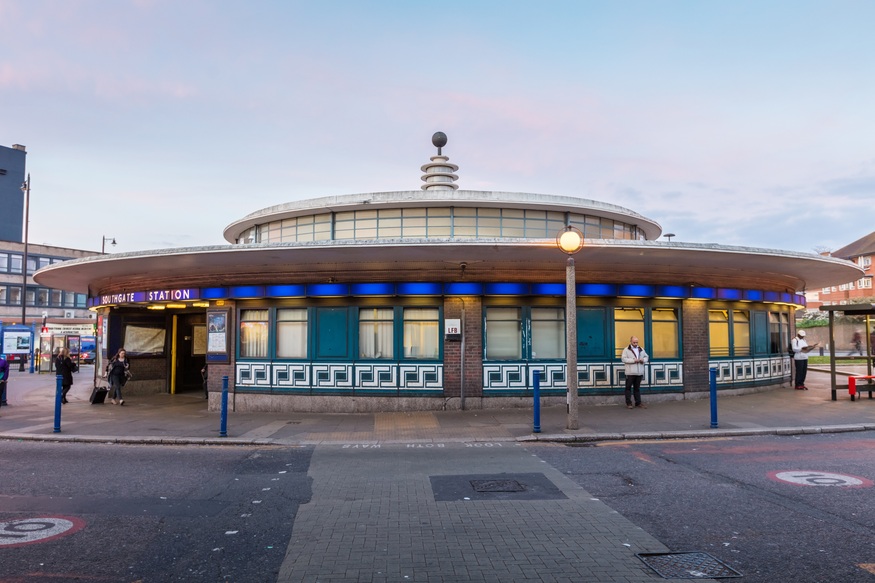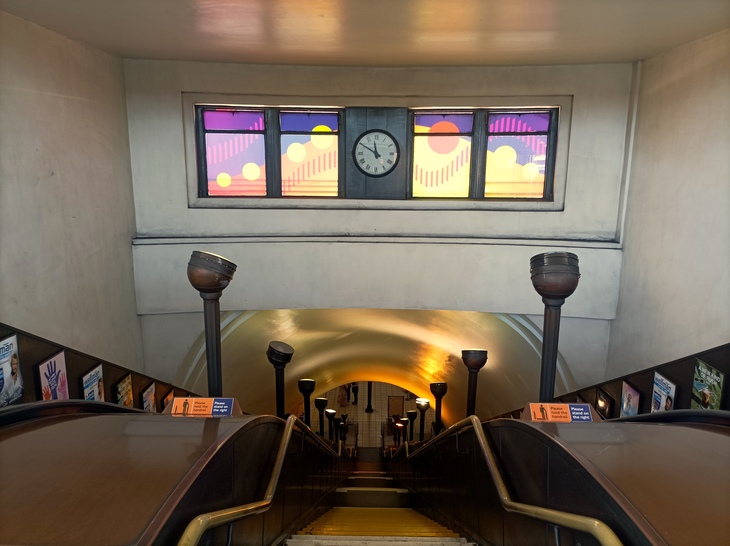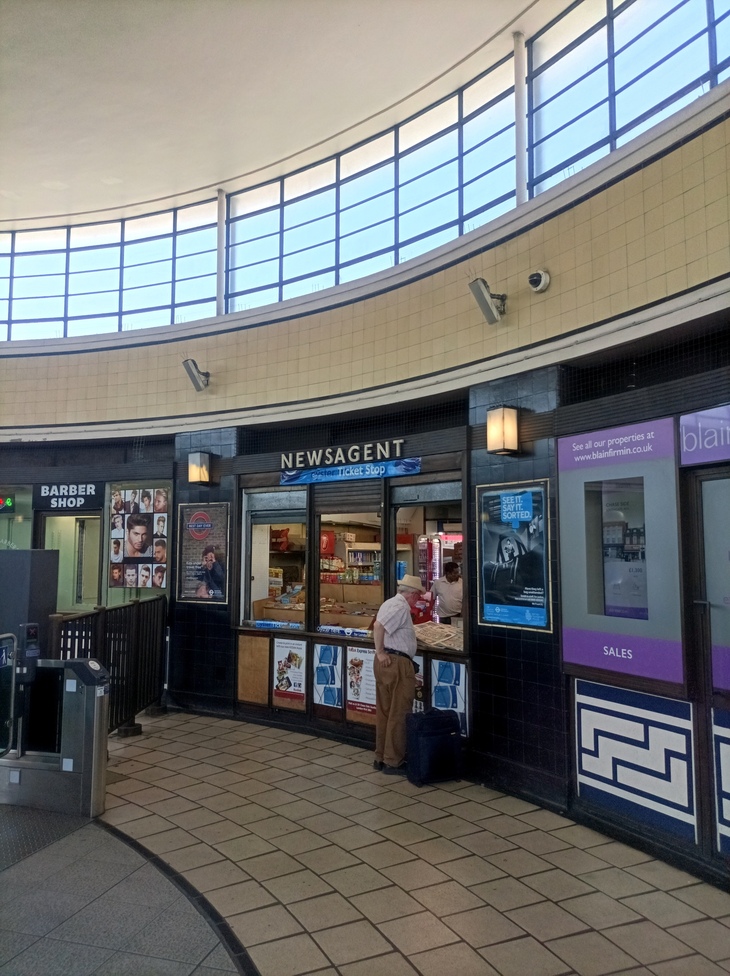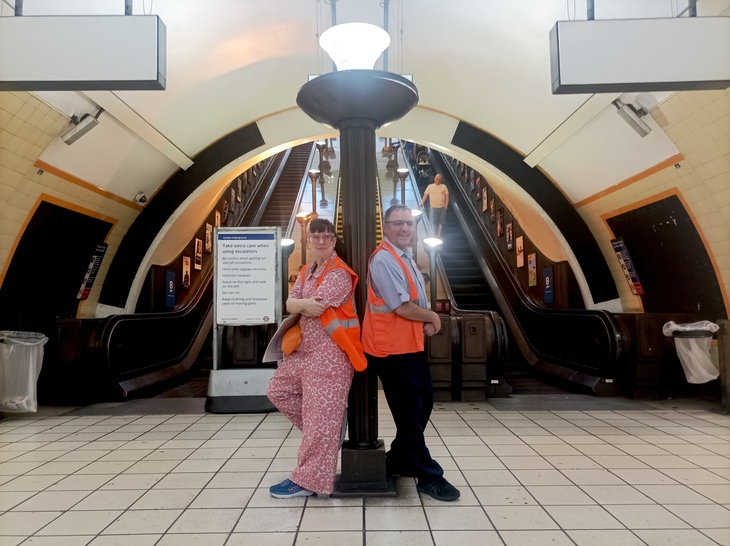For more of all things London history, sign up for our new (free) newsletter and community: Londonist: Time Machine .

One day in 1933, the unassuming spot of Five Ways Corner in Southgate was visited by a flying saucer — and this part of north London was never the same again.
Maybe that's not quite how it happened. But when Southgate station arrived in north London as part of the Piccadilly line extension in 1933 — replacing a blacksmith's that'd stood there for yonks — you wonder if the locals thought little green men might start waddling out of this alien composition. Especially when it radiated neon blue at night.

By the tail end of the 1920s, Finsbury Park remained the northernmost station on the Piccadilly line, and the trams and buses shuttling passengers upwards from here were becoming uncomfortably crowded. An extension to Cockfosters was proposed, and London Transport head honcho Frank Pick had in his sights starchitect in the making, Charles Holden, to dream up the string of new stations.


Holden had already made his mark on the London Underground, thanks to his sweep of mid 1920s Northern line stations: these double-height Portland stone portals cut a bold and dashing figure from Morden to Warren Street, while transmitting a funereal stateliness, imbued from Holden's previous gig as a war memorial architect.
His Piccadilly line stations were going to be different though — almost unimaginably so. In 1930, Holden and Pick travelled around northern Europe in search of inspiration — a kind of 20th century Grand Tour, with classicism substituted for modernism. In Stockholm, the pair visited the Stockholmsutställningen, an exhibition flaunting the streamlined new aesthetics of Functionalism and International Style. Pick and Holden liked what they saw. "Holden came back and his mind changed," says Ann Gavaghan, Customer Experience Manager at TfL, "The influence of what he saw there: materials of bricks, the circular shapes, the rectangular geometric shapes — Swedish modernist architecture in particular —- influenced his designs for the underground."


Plans for eight new stations — Manor House, Turnpike Lane, Wood Green, Bounds Green, Arnos Grove, Southgate, Enfield West (now Oakwood) and Cockfosters — were drawn up. But it was Southgate that would make the most impact.
"This is an absolutely gorgeous station, it's one of my favourites on the network," says Gavaghan, as we stand by the entrance, admiring Holden's extraterrestrial masterpiece, 90 years after it was first unveiled. Call it art deco space age, call it streamline moderne — call it Googie before Googie existed — this is a belter of a design. Of the 272 tube stations, Southgate sits in the higher echelons of the god tier — maybe even hovering above it.


Mind you, Holden can't take all the credit. A visionary he may have been, but he wasn't afraid to lift architectural motifs that caught his eye. The bulb finial that tops Southgate station — and pulls together the whole 1950s B-movie look — is a feature that appeared at Stockholmsutställningen, and which Holden thought he quite fancied a piece of. His blueprints for nearby Arnos Grove unabashedly took their cue from Stockholm Public Library. Whisper it, but TfL may owe some royalties to Sweden.
Going round in circles

The hypnotic beauty of Southgate is not just about the station building, but everything around it. Circular 'mushroom' bus shelters orbit it like satellite moons, as do globe-shaped lamps perched on stylish concrete posts. The redbrick station parade swooshes around one side of Southgate station in a liquid motion. Traffic encircling the Five Ways island forms an asteroid belt of metal and fumes. Inside, the circular motif continues, from the round concourse, to the clock above the escalators. Dan Maier's lavalamp-esque designs — originally only supposed to be here for a week or two, but loved so much by the staff they've stayed — repeat the themes of circles, globes, planets, movement. Everything at Southgate is cyclical, everything is cosmic.


"This is a great and early example of unified urban design," says Gavaghan, pointing out the various shops that still inhabit the station, including a newsagents, and a tailor selling 'wedding suits'. (In a satisfying touch of conformity, all the shop signs here are printed in Johnston.) There are places to get a drink, sit with your drink, watch the world go by with your drink, before journeying onwards into the all-sacrificing mission that is being a Londoner.
Brassier than a Carry On film

We're joined by Customer Service Manager, Kevin Eva, who's worked at Southgate since the late 1980s, and still gushes about the place with a zeal that suggests he started here last Monday. Together, the pair excitedly wheedle out all the wonderful titbits as we embark on a Southgate safari: one of the few passimeters left on the network — crowned by a pulsating radio antennae form. The fact the escalators are numbered 1 and 3 (in case the stairs sandwiched between them are one day converted into escalator 2). Holden's meticulous attention to detail — from his interlocking geometric forms found in panels on the concourse, to the rippled, electric yellow arches that usher you onto the platforms. It's all so dynamic, all so Bright Young Things.

Southgate's space age exterior belies a smart 1930s heart. The insides of the station are lacquered with brass and bronze like they're going out of fashion. The escalators here are the only ones on the tube network to still bear their globular Waygood Otis badges. Flanked by brass up-lighters, the ride up or down reminds you of those roving spotlights in the 20th Century Fox titles. This is golden age Hollywood glamour (indeed, they were installed the same year that moviegoers were fawning over the original King Kong).


From the cuboid light fittings flanking the shop fronts, to the cash trays in the closed down ticket offices, Southgate is brassier than a late 1970s Carry On film. During the last refurb at Southgate, the bronze was made gleaming gold, only for employees to be told by a heritage expert they'd got it wrong: "Someone came along and said 'no, gotta darken it all !'" says Kevin. And so the bronze was muddied.
Tunnels full of secrets

Southgate station is hardly a secret. Even if people don't know it by name, they'll refer to 'that station that looks like a flying saucer'. Like the Taj Mahal, you don't have to have been to know it's there. More recently, the station came to the wider attention of the world, when it was momentarily renamed after a certain England football manager. Only on closer inspection, though, do you discover its century-worth of delicious secrets: a fuse box dating back to the 1930s (who knew the could be beautiful?); a staff letter box on one of the platforms; the 'escalator comb', which can be used to unscrew an escalator in case anything gets trapped in there.

The station continues to throw up new secrets. Kevin Eva recently noticed that one of the decorative metal panels on the outside of the station wasn't rusting like the others. That was because it wasn't actually metal; when the former entrance was filled in, it was done with a cost-cutting facsimile made of wood. "That's something that'll have to be seen to," grins Eva, "there's always something."

We pass through a door marked 'staff only' to find ourselves in a tunnel, with bare lining rings. It used to be used by maintenance workers to access the line and store their tools. "These would be absolutely full up with everything you need to work on the track," says Eva. Little is kept here now, but there is a window which provides a wonderful view of the bottom half of trains rolling in and out of the station.

A secret that anyone visiting Southgate can appreciate is its unique position as a subterranean station in the middle of two above ground ones (Arnos Grove and Oakwood). From the platform — and be careful there are no trains coming — you can see light at the end of the tunnel in both directions. It feels rather odd.
The most (and least) photographable tube station

As Holden began working with other architects, the relationship between himself and Frank Pick began to fray. Then the second world war came along, putting the kibosh on further building plans for the Underground for a while. The golden era was already at an end — but boy, had it been fruitful. "It was really lucky that we had this period of huge expansion," says Ann Gavaghan, "and if you think about the growth of the Underground from 1900 to 1935, and how many new stations were added during that time — it's over 90 stations. It's amazing."

In its 90 years on this planet (let alone its previous life on whichever planet it came from), the clutter of modern day life has taken its toll on Southgate station. The facade is grubbied. Various pieces of the furniture are pulled out and taken away to be polished up. The antennae on top of the roof should be gold, and one day soon will be again. It's no small irony that finding a clear sightline of one of London's most photogenic tube stations is now a herculean task. Given the sheer amount of buses and urban clutter encircling it, you need to be up at the crack of dawn just to be in with a chance of snapping the station in any kind of serenity. You must stake it out like you're trying to capture a fleeting glimpse of a UFO. But photographers like Tubemapper will happily do just that, because this station is just worth it.


Southgate station is a one of a kind, and it's a blessing in disguise that Holden only ever got to create one. It slaps the area firmly on the map, gives it a large slice of its own identity. "What these stations allow is people to feel pride in something unique at their station," says Gavaghan, about the Piccadilly line extension, "So Southgate is associated with this station, and it's become a symbol for the local community. And I really love that."



